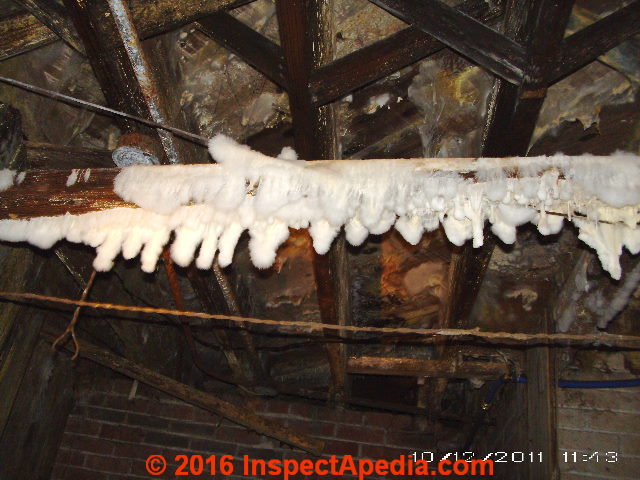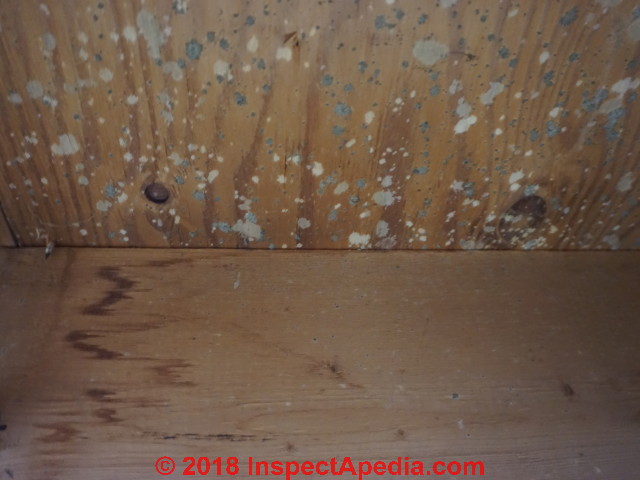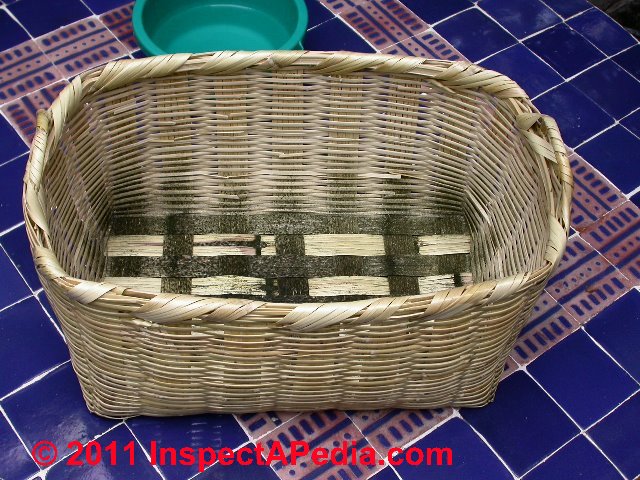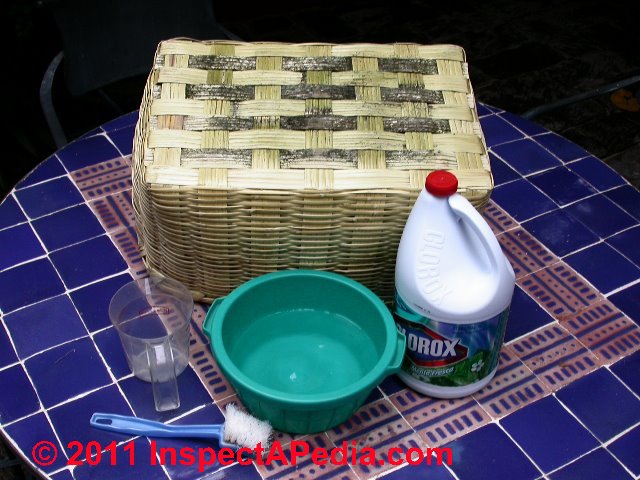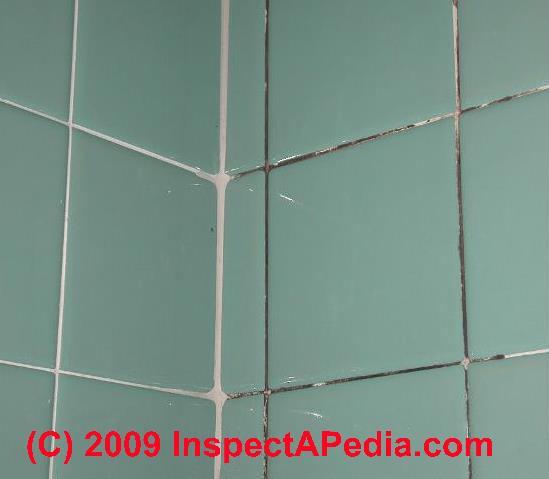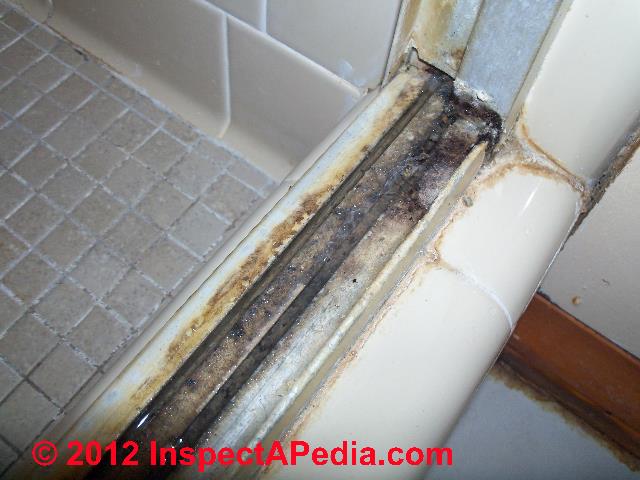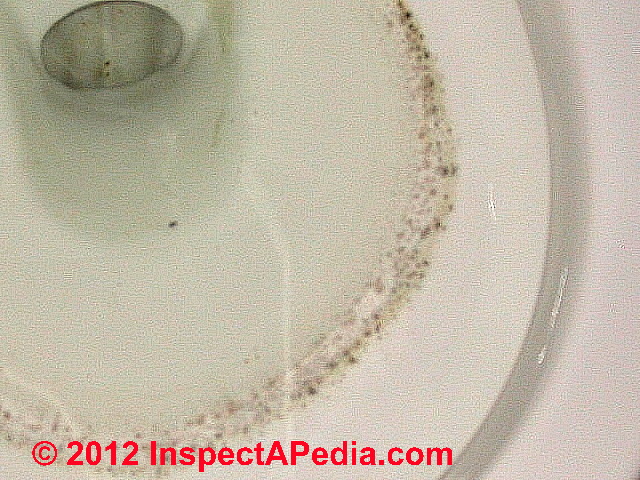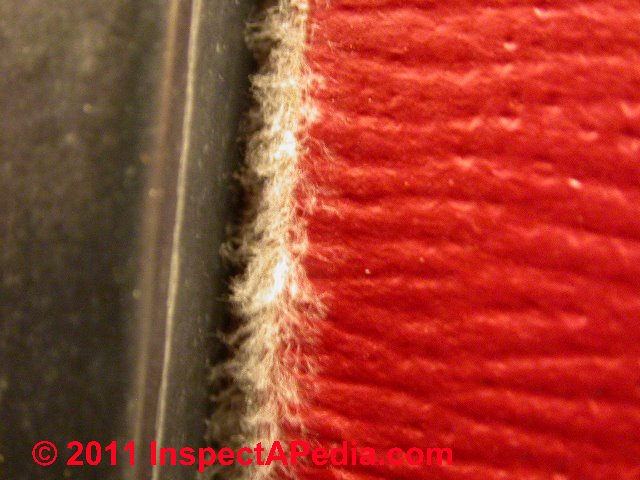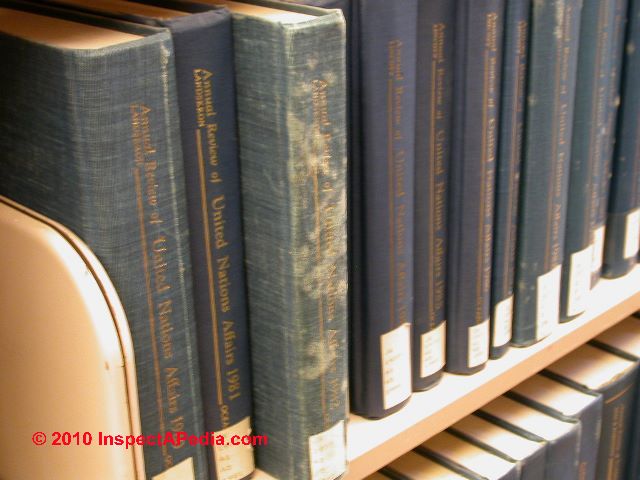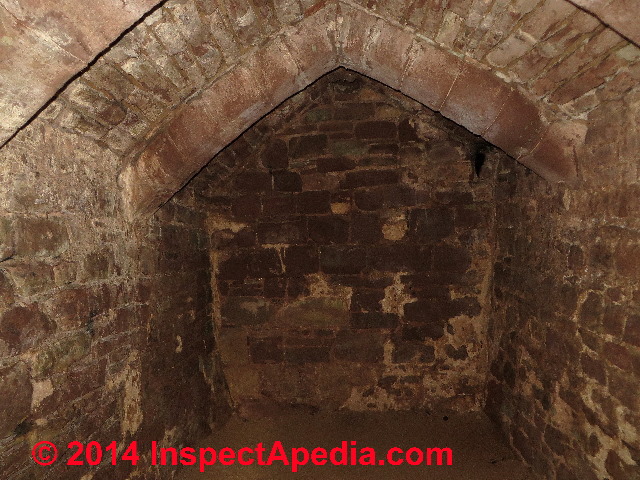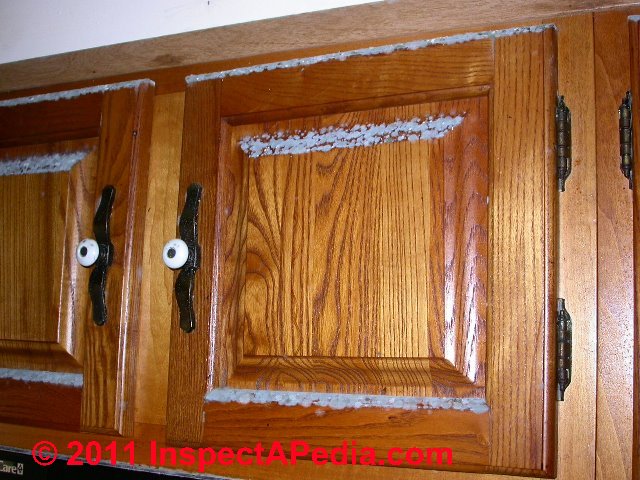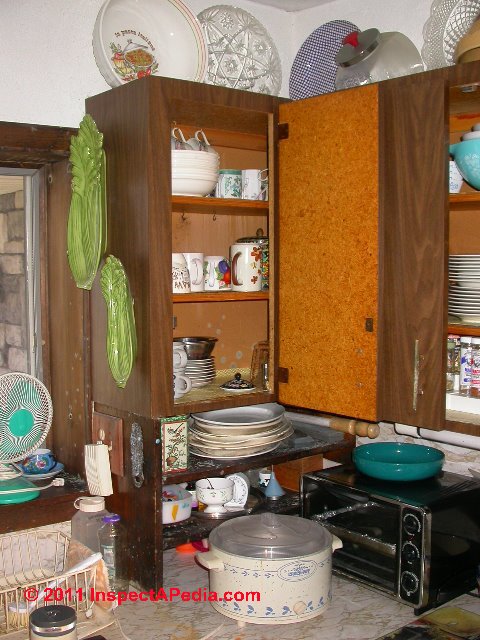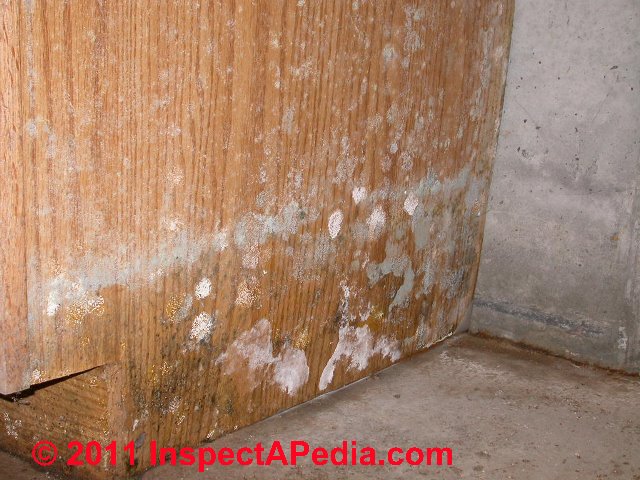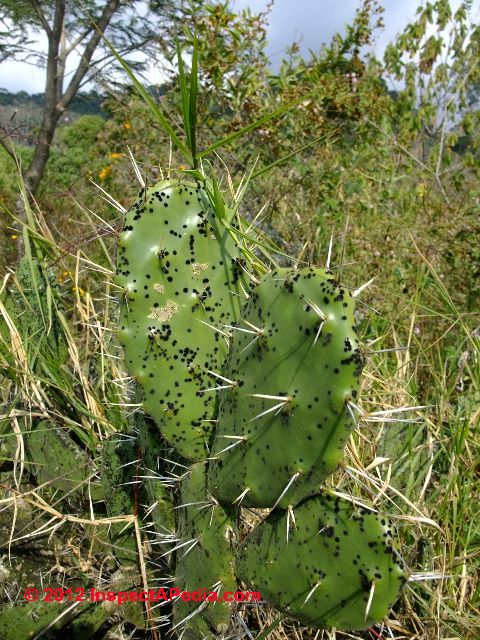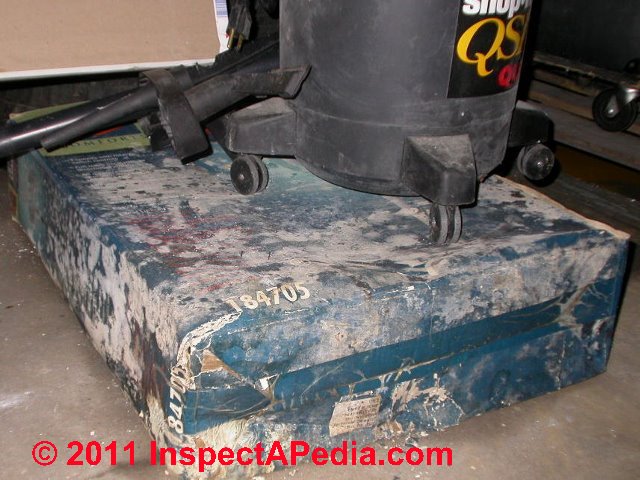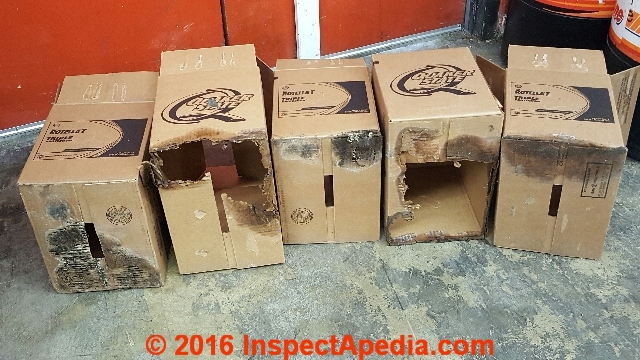 Mold In-Situ: Photos of Mold on Surfaces - Group 2
Mold In-Situ: Photos of Mold on Surfaces - Group 2
Appearance of Mold on Different Materials
- POST a QUESTION or COMMENT about what mold looks like in buildings, including mobile homes and trailers
Photographs of mold growth in buildings:
Here is an extensive photo guide to fungi, mushrooms & mold growing on all kinds of surfaces of all kinds of materials found on or in buildings:
Mold on baskets, woven goods, bathroom controls, bathroom surfaces, mold on bedding, sheets, pillowcases, moldy books, mold regrowth on bleached surfaces, mold on bricks, mold on or in or under cabinets, mold on cactus plants, mold on cardboard.
These photos of mold on indoor various materials or "mold growth substrates" may help you recognize mold in buildings, recognize probably-cosmetic mold, and recognize stuff that is not mold and does not need to be tested.
InspectAPedia tolerates no conflicts of interest. We have no relationship with advertisers, products, or services discussed at this website.
- Daniel Friedman, Publisher/Editor/Author - See WHO ARE WE?
Pictures of Mold on Various Building Surfaces and Materials
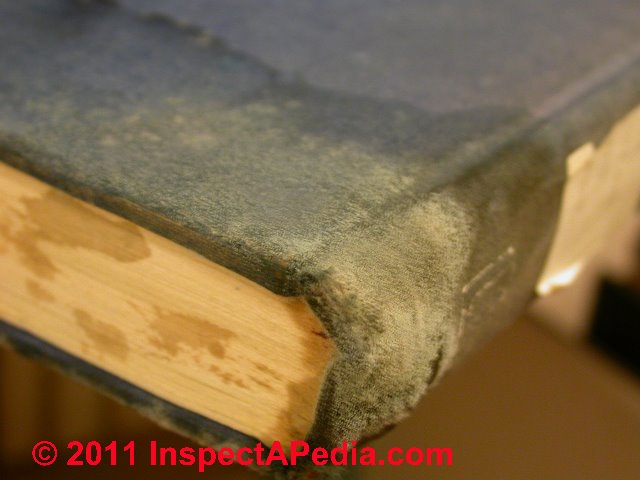 Here we provide a large collection of in-situ photographs of all types of mold growths found in buildings. Mold on baskets, woven goods, bathroom controls, bathroom surfaces, mold on bedding, sheets, pillowcases, moldy books, mold regrowth on bleached surfaces, mold on bricks, mold on or in or under cabinets, mold on cactus plants, mold on cardboard.
Here we provide a large collection of in-situ photographs of all types of mold growths found in buildings. Mold on baskets, woven goods, bathroom controls, bathroom surfaces, mold on bedding, sheets, pillowcases, moldy books, mold regrowth on bleached surfaces, mold on bricks, mold on or in or under cabinets, mold on cactus plants, mold on cardboard.
We illustrate what mold looks like on various building surfaces & materials as well as on items often found in buildings, including foods, fruits, vegetables, even water. [Click to enlarge any image]
For page loading speed we have divided this article into several sections.
Use the link
MOLD APPEARANCE on VARIOUS SURFACES - INDEX
to return to the index / list of photographs of the appearance of mold on various building materials & contents.
--- MOLD GROWTH on MATERIAL SURFACES PHOTOS GROUP 2 ---
- MOLD on BASEMENT SURFACES wood, framing, insulation, other surfaces - please also see this detailed article BASEMENT MOLD
- MOLD on BASKETS and woven organic materials
- MOLD on BATHROOM CONTROLS
- MOLD on BATHROOM SURFACES
- MOLD on BEDDING - such as pillowcases, sheets; varies by material type, cotton
- MOLD on BLEACHED SURFACES - yep, mold is still present and may sill be viable
- MOLD on/in BOOKS & book bindings, papers, documents, photos, "foxing"
- MOLD on BRICK surfaces outdoors or inside
- MOLD on/in CABINETS and Vanities
- MOLD on CACTUS in la Yerbabuena, at the foot of the Colima Volcano, Mexico. Also see MOLD on CACTUS, NOPAL PRICKLY PEAR MOLD - separate article.
- MOLD on CARDBOARD such as boxes
Photographs of mould found on the surface of items, materials, & surfaces found indoors
Mold on Basement Surfaces
Above: thick fungal growth on wood framing over a wet basement.
[Click to enlarge any image]
Below: a less-dramatic but far more-common example of mold growth on wood surfaces in a basement ceiling: mold has contaminated the plywood subflooring overhead.
See a detailed description of mold commonly found in basements and more about this moldy plywood photo in this article on BASEMENT MOLD
Mold on Baskets and woven organic materials
These photographs illustrate mold growth on a woven laundry basket made in Mexico. Damp clothes left in the basket led to mold growth even though the climate itself is a very dry one.
All mold is everywhere all the time. All that's needed is the right growing conditions to encourage the growth of mold spores that find a lucky resting spot as they settle out of the air.
It is also interesting to observe that mold grew more readily on the split (and rough surfaced) side of the reed material used to form the basket.

As you can see we experimented with cleaning this mold using a dilute bleach solution.
It was not successful and we decided the best course was to dispose of the basket.

Mold on Bathroom Controls and Surfaces
These bathroom mold photos illustrate where hidden mold may be found around bath fixture controls, a common point of leakage into the bathroom wall.
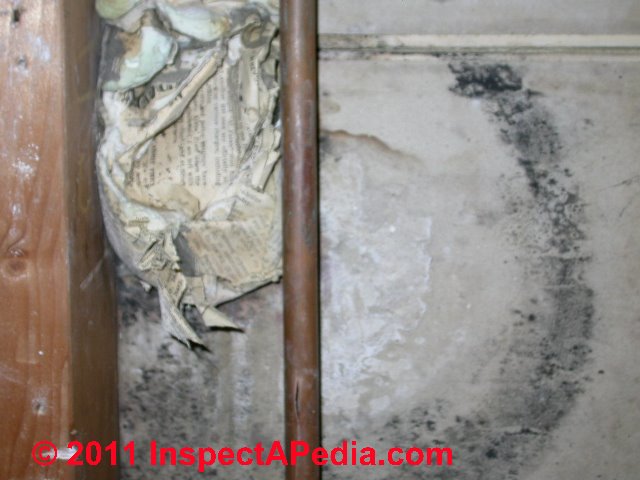
Mold on Bathroom Surfaces: bath tile, bath tile grout, shower enclosures
Our photos below show the most common location of mold in tiled bathrooms - in grout or caulk joints.
This mold is rarely sufficient to form a health concern, but it might be an indicator of leaks into the bath wall cavity - a greater concern for possible hidden mold and hidden damage.
See BATHROOM MOLD for more detail about mold on bathroom surfaces including tile and tile grout.

Below we illustrate other locations where mold may accumulate in bathrooms.
In addition to finding mold growth on aluminum surfaces (more likely growth supported by soap scum and skin cells), we have found mold growth on ceramic toilets and sinks (more likely supported by condensation or water splash combined with organic dust or organic waste).
Also see MOLD on TUB & TILE GROUT & CAULK
Watch out: we warn at MOLD on TILE, CERAMIC that while the quantity of visible mold on grout in a bathroom is likely to be trivial and the species harmless or just allergenic, if you see evidence of leaks into the ceiling, wall or floor cavity of a bath or other tiled area, or if y ou find mushrooms growing out of floor trim we know there has been a history of flooding or recurrent leaks - and we look for both hidden mold colonization and hidden structural damage.
Also see MOLD BEHIND MARBLE or TILE - hidden mold contamination
Also see BATHROOM MOLD- how to recognize, clean off & prevent bathroom mold growths. Is bathroom mold dangerous?
When does bathroom mold growth or similar black or brown mold growths in buildings suggest hidden leaks and water damage? How do we address mold growth behind or under bathroom or kitchen cabinets or vanities?
Bedding, blankets mattresses, sheets, pillowcases
This leather jacket photograph (below left) illustrates mold growth on articles of clothing - in this case a leather jacket left in a damp area. But we also find mold growth on fabric clothing, both natural fibers and synthetics, depending on the exposure conditions.

Mold growth photos above illustrate an extremely moldy home that suffered mold growth on the bed headboard, pillow cases, sheets, quilt, all bed coverings.
A mattress (photo above) or pillow that has been soaked by flooding are simply replaced.
Even though it is usually possible to wash or clean linens exposed to moldy conditions, just as in the case of upholstered furniture, actual mold growth on pillows, mattresses, quilting at this level justifies their disposal.
Also see MOLD on CLOTHING, CLOTH - varies by material type, cotton, wool, etc.
CONTACT us to submit photographs of mold growth on other man-made or building-related materials.
Mold on Bleached Surfaces - yep, mold is still present and may sill be viable

This photograph illustrates mold growth on building surfaces that had been "remediated" by a contractor who splashed bleach on the surfaces, or on some of them.
Watch out: bleaching moldy surfaces may be desirable for aesthetic purposes but it is not the proper way to remove and cure a mold contamination problem.
You need to remove the mold from surfaces that can be cleaned, dispose of materials that cannot be cleaned, and you need to find and fix the cause of leaks or moisture that were key in the problematic mold growth in the first place.
- See MOLD KILLING GUIDE for details on why trying to kill mold is ineffective and possibly even dangerous.
- See MOLD CLEANUP with BLEACH if you insist
- See MOLD CLEANUP GUIDE- HOW TO GET RID OF MOLD for a complete guide
Mold on Books, Documents, Papers, Photos
Our book-mold pictures show mold growth on books that had been shelved in a library basement in which the relative humidity had not been controlled (below right) and where some books had been wet (below left).
As we discuss at MOLD AGE, HOW OLD is the MOLD? the moldy books in a college library (photo below) were in the opinion of some people "an old inactive mold problem" but when workers began dehumidifying the area in preparation for a mold cleanup, visible clouds of Aspergillus sp. spores were released into the air by small air currents caused by simply walking down the aisle between stacks of books.
See BOOK / DOCUMENT MOLD & WATER DAMAGE RESTORATION for details about dealing with and restoring moldy books and papers.
See FOXING STAINS on books & papers for details about these stains and marks on books and papers.
Mold on Brick Surfaces
This photograph illustrates mold or algal growth on a stone and masonry surface - black and brown stains on brick and stone of the dungeon at Goodrich Castle, Ross on Wye, in England.
See STAINS on BRICK SURFACES for details.
Without microscopic analysis it is difficult to distinguish between algae on building exteriors and mold growth that sometimes also occurs in those locations.
Mold on Cabinets and Vanities
These cabinet mold photos show mold growth occurring first on the near-horizontal surfaces of wood cabinet doors in a home where flooding had gone undiscovered for several months.
We speculate that an extra layer of dust, including grease and organic debris on these surfaces was a factor in the more extensive mold growth on those locations.
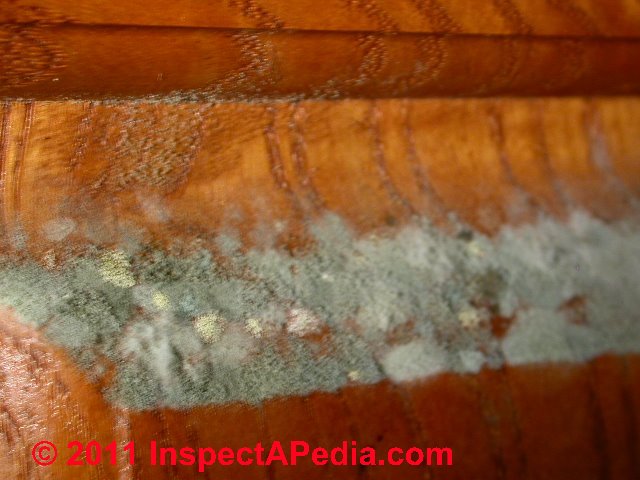
But as you can see from our next pair of mold photos, fungal growth can become quite extensive on the smooth vertical sides and faces of kitchen or bathroom cabinets where moisture levels are sufficient.
...
Mold grows readily on the interior of kitchen and bathroom cabinets as well, as we illustrate below.
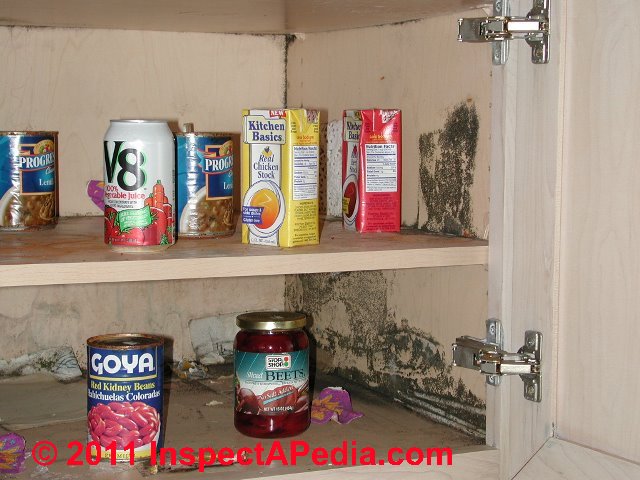
Watch out: the indoor cabinet mold photos below illustrate why experienced mold remediators and insurance company adjusters assure that cabinets are removed from walls in a home where there has been flooding or leaks from above.
The un-coated back side of wall-hung or floor-mounted cabinets are a ready home for hidden mold growth.

It would have been a mistake to leave these cabinets mounted to the wall of the home where they were found, even though mold was not visible on the room side of exposed wall surfaces.
And further investigation of the wall cavity behind where these cabinets had been mounted confirmed that the cavity side of the wall needed to be cleaned as well.
See BATHROOM MOLD for notes about finding mold beneath or behind bathroom cabinets.
At CABINETS & COUNTERTOP DEFECTS we discuss water damage to those components.
Mold on Cactus
Mold growth on cactus is more common in areas where cacti such as the Mexican Nopal (below left) grows in higher and less arid regions such as la Yerbabuena, near the foot of the volcano above Colima, Mexico.
(Photographs by DF, la Yerbabuena, November 2011)
Our cactus mold photo (at left, 1200x) has been tentatively identified but we continue to seek expert help from horticultural and mycology experts in confirming its identity to species.
Mold & mildew infection of cactus plants are discussed in detail
at MOLD on CACTUS, NOPAL PRICKLY PEAR MOLD
Mold on Cardboard such as boxes
Mold growth on cardboard occurs readily in damp or wet areas. Both of the boxes shown in these photos had been located on a wet basement floor.

But the mold on the cardboard box shown below was less obvious. Notice the dark stains and spots along the bottom third of the carton at left ?
Below our moldy box photograph illustrates mold growth on a cardboard box in a damp basement not exposed to flooding.
In contrast, next photo, below, is of a cardboard box that has been exposed to flooding.
The characteristic dark and uneven edges at the top of the water-stained box show us the combination of sitting in water and water wicking upwards in the cardboard.
CONTACT us to submit photographs of mold growth on other man-made or building-related materials.
Above we see mold on wet cardboard boxes used to store Quaker State motor oil, contributed by reader [Anonymous] 2016/08/25 by private email. The reader commented and then asked:
Might be from a leak from neighbors bathroom. No product leaked out of containers in boxes, but was asked if mold and mushrooms can grow in clean motor oil.
Motor oil, itself toxic to most living organisms, will not be found supporting visible mold growth. On the other hand, it is not accurate to say that absolutely no microorganisms "grow" in or function in motor oils. Walker (1975) discussed the effects of thermophilic bacteria and mold on the break down of motor oil of the type likely to be found in nearshore wastewater discharges and wastewater. See
- Al-Maghrabi, Ibrahim MA, AO Bin Aqil, M. R. Islam, and O. Chaalal. "Use of thermophilic bacteria for bioremediation of petroleum contaminants." Energy Sources 21, no. 1-2 (1999): 17-29.
- Lefcort, H., K. A. Hancock, K. M. Maur, and D. C. Rostal. "The effects of used motor oil, silt, and the water mold Saprolegnia parasitica on the growth and survival of mole salamanders (Genus Ambystoma)." Archives of Environmental Contamination and Toxicology 32, no. 4 (1997): 383-388.
- Ijah, U. J. J., and L. I. Ukpe. "Biodegradation of crude oil by Bacillus strains 28A and 61B isolated from oil spilled soil." Waste Management 12, no. 1 (1992): 55-60.
- Ludzack, F. L., and Diana Kinkead. "Persistence of oily wastes in polluted water under aerobic conditions." Industrial & Engineering Chemistry 48, no. 2 (1956): 263-267.
- Stone, R. W., M. R. Fenske, and A. G. C. White. "Bacteria attacking petroleum and oil fractions." Journal of bacteriology 44, no. 2 (1942): 169.
- Walker, J. D., R. R. Colwell, and L. Petrakis. "Bacterial degradation of motor oil." Journal (Water Pollution Control Federation) (1975): 2058-2066.
...
Continue reading at MOLD GROWTH on SURFACES, PHOTOS_GROUP_3 or select a topic from the closely-related articles below, or see the complete ARTICLE INDEX.
Or see these
Mold Identification Articles
- BLACK MOLD, HARMLESS
- MOLD APPEARANCE on VARIOUS SURFACES index to photos of mold on all kinds of surfaces and materials
- MOLD APPEARANCE - WHAT MOLD LOOKS LIKE - home
- MOLD APPEARANCE - STUFF THAT IS NOT MOLD
- MOLD ATLAS & PARTICLES INDEX
- MOLD FREQUENCY in BUILDINGS
- MOLD in BUILDINGS
- MOLD CONTAMINATION IN BUILDINGS - home
- MOLD by MICROSCOPE - mold under the microscope
- MOLD in the PETRI DISH, PHOTOS - mold on culture plates or in culture-type mold test kits
- MOLD RELATED ILLNESS SYMPTOMS
Suggested citation for this web page
MOLD GROWTH on SURFACES, PHOTOS_GROUP_2 at InspectApedia.com - online encyclopedia of building & environmental inspection, testing, diagnosis, repair, & problem prevention advice.
Or see this
INDEX to RELATED ARTICLES: ARTICLE INDEX to MOLD CONTAMINATION & REMEDIATION
Or use the SEARCH BOX found below to Ask a Question or Search InspectApedia
Ask a Question or Search InspectApedia
Try the search box just below, or if you prefer, post a question or comment in the Comments box below and we will respond promptly.
Search the InspectApedia website
Note: appearance of your Comment below may be delayed: if your comment contains an image, photograph, web link, or text that looks to the software as if it might be a web link, your posting will appear after it has been approved by a moderator. Apologies for the delay.
Only one image can be added per comment but you can post as many comments, and therefore images, as you like.
You will not receive a notification when a response to your question has been posted.
Please bookmark this page to make it easy for you to check back for our response.
IF above you see "Comment Form is loading comments..." then COMMENT BOX - countable.ca / bawkbox.com IS NOT WORKING.
In any case you are welcome to send an email directly to us at InspectApedia.com at editor@inspectApedia.com
We'll reply to you directly. Please help us help you by noting, in your email, the URL of the InspectApedia page where you wanted to comment.
Citations & References
In addition to any citations in the article above, a full list is available on request.
- In addition to citations & references found in this article, see the research citations given at the end of the related articles found at our suggested
CONTINUE READING or RECOMMENDED ARTICLES.
- Carson, Dunlop & Associates Ltd., 120 Carlton Street Suite 407, Toronto ON M5A 4K2. Tel: (416) 964-9415 1-800-268-7070 Email: info@carsondunlop.com. Alan Carson is a past president of ASHI, the American Society of Home Inspectors.
Thanks to Alan Carson and Bob Dunlop, for permission for InspectAPedia to use text excerpts from The HOME REFERENCE BOOK - the Encyclopedia of Homes and to use illustrations from The ILLUSTRATED HOME .
Carson Dunlop Associates provides extensive home inspection education and report writing material. In gratitude we provide links to tsome Carson Dunlop Associates products and services.


